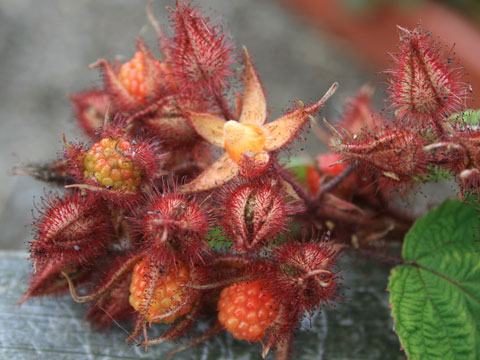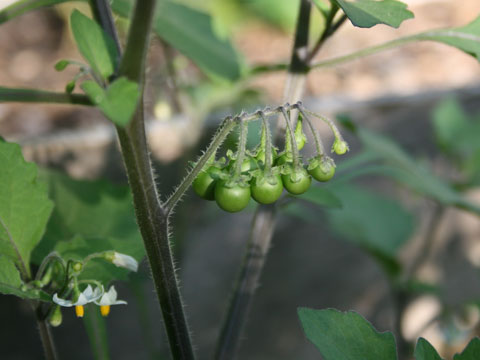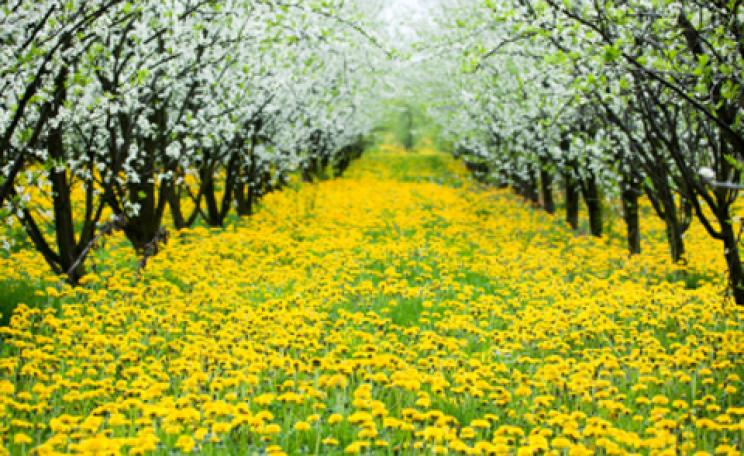Fruits are the jewels of any kitchen garden, but if you like unusual edibles then you're in for a treat, because many of the most productive and unusual plants produce delicious fruit that you'd be hard-pressed to find anywhere else.
Take the medlar, for example. Once upon a time it used to be a popular fruit tree, but now it is rare to find one outside of a botanic garden. Why? Because the medlar's fruit needs processing before it can be eaten. Once mature, the fruit is harvested from the tree and stored so it can 'blet' - rot, essentially - to the point where the flesh is soft enough to eat with a spoon. Although it may sound yukky to those who are accustomed to shrink-wrapped and perfect supermarket produce, the medlar is supposed to be a gourmet treat that tastes like spiced fruit and needs no added sugar.
The medlar (Mespilus germanica) makes quite a large tree, growing up to 6m tall, but there are plenty of unusual fruits suitable for smaller spaces.
 The Japanese wineberry (Rubus phoenicolasius) is in the same plant family as raspberries and blackberries, but while it grows in a very similar manner, with long arching stems, it has several differences. The first is the lovely red colour of its stems, which are spiny but not as sharp as a blackberry: they scratch rather than prickle. The fruits are encased in a calyx until they're ripe, protecting them from both birds and maggots, and are another almost unheard-of treat.
The Japanese wineberry (Rubus phoenicolasius) is in the same plant family as raspberries and blackberries, but while it grows in a very similar manner, with long arching stems, it has several differences. The first is the lovely red colour of its stems, which are spiny but not as sharp as a blackberry: they scratch rather than prickle. The fruits are encased in a calyx until they're ripe, protecting them from both birds and maggots, and are another almost unheard-of treat.
 The goji berry (Lycium barbarum) is well-known and widely used in Asia, and is becoming known as a superfruit here. It's a bushy plant, producing small, bright-red berries on arching stems - they stand well into winter and look like tiny Christmas lights. The fruits are an acquired taste, but can be used for herbal teas and fruit leathers. The plants themselves can be unruly and do grow spines, so are best placed away from paths!
The goji berry (Lycium barbarum) is well-known and widely used in Asia, and is becoming known as a superfruit here. It's a bushy plant, producing small, bright-red berries on arching stems - they stand well into winter and look like tiny Christmas lights. The fruits are an acquired taste, but can be used for herbal teas and fruit leathers. The plants themselves can be unruly and do grow spines, so are best placed away from paths!
 Far more well-behaved are alpine strawberries (Fragaria vesca). These bushy little plants bear tiny, intensely flavoured strawberries on upright stems, which keeps them away from slugs and woodlice. They are spread by seed, not runners, and as they appreciate partial shade they make a good edible groundcover. They fruit all through the season, but it's unlikely you'll harvest any more than a handful or two at any time. Keep an eye out for the white variety, which is surprisingly tasty and less attractive to birds.
Far more well-behaved are alpine strawberries (Fragaria vesca). These bushy little plants bear tiny, intensely flavoured strawberries on upright stems, which keeps them away from slugs and woodlice. They are spread by seed, not runners, and as they appreciate partial shade they make a good edible groundcover. They fruit all through the season, but it's unlikely you'll harvest any more than a handful or two at any time. Keep an eye out for the white variety, which is surprisingly tasty and less attractive to birds.
Popular in the US but only recently arriving on the UK gardening scene is the honeyberry (Lonicera caerulea spp.), a fruiting honeysuckle. The blue berries are a blueberry substitute. Native to Siberia, they're really hardy, and they don't need the ericaceous (acid) soil that blueberries love and which makes them hard to grow for many gardeners. You'll need two plants to ensure pollination, and they should be sold in suitable pairs. Once settled, your bushes should be drought-tolerant and productive for decades, although it will be a year or two before they start to bear fruit.
Those are all perennial plants - they live for many years and won't be at their most productive in their first season. But there are plenty of unusual fruits that are annuals, if you're looking for a quick fruity fix:
 Wonderberries (Solanum burbankii) are grown from seed in a similar way to tomatoes, which is unsurprising as they are related. These bushy plants grow quickly and by the end of summer are laden with small, black fruits. Although they're not tasty raw, they are good cooked and so are great as fruit leathers, in jam or added to pies. Any berries that fall to the ground will happily grow into new plants next year, but they do look very similar to deadly nightshade, so be sure you know what you're eating. Wonderberries have white flowers, whereas deadly nightshade's are purple. Wonderberries like growing in the ground; they aren't very productive when confined to containers.
Wonderberries (Solanum burbankii) are grown from seed in a similar way to tomatoes, which is unsurprising as they are related. These bushy plants grow quickly and by the end of summer are laden with small, black fruits. Although they're not tasty raw, they are good cooked and so are great as fruit leathers, in jam or added to pies. Any berries that fall to the ground will happily grow into new plants next year, but they do look very similar to deadly nightshade, so be sure you know what you're eating. Wonderberries have white flowers, whereas deadly nightshade's are purple. Wonderberries like growing in the ground; they aren't very productive when confined to containers.
 Another fruiting plant at home in the vegetable patch is strawberry spinach (Chenopodium capitatum). It has many other names, including strawberry blight (or blite), beetberry and strawbini. This plant is related to the common weed Fat Hen (C. album) and it grows into an upright leafy plant approximately half a metre tall. The leaves can be used as a spinach substitute and are best eaten when they're young, but this plant also goes on to bear red fruits. They look a bit like strawberries (hence the name) but have nowhere near as much flavour. They make an interesting addition to a mixed salad, however, or can be used to pack out fruit pies and jams.
Another fruiting plant at home in the vegetable patch is strawberry spinach (Chenopodium capitatum). It has many other names, including strawberry blight (or blite), beetberry and strawbini. This plant is related to the common weed Fat Hen (C. album) and it grows into an upright leafy plant approximately half a metre tall. The leaves can be used as a spinach substitute and are best eaten when they're young, but this plant also goes on to bear red fruits. They look a bit like strawberries (hence the name) but have nowhere near as much flavour. They make an interesting addition to a mixed salad, however, or can be used to pack out fruit pies and jams.
 If you'd like to grow something impressive to serve to guests then take a look at goldenberries (Physalis peruviana), also known as Cape gooseberries. These bushy plants can become quite large, but there are also smaller varieties that are easier to grow in containers. They are frost-tender, but can be grown like tomatoes and are happy in sheltered spots outside if you don't have a greenhouse. They have pretty yellow flowers that are followed by fruits that grow in ornamental paper cases. Once the fruits are ripe they fall to the ground - still encased in their papery shells - which makes harvesting a doddle. They look lovely served in a bowl with their shells folded back, or as a garnish. If you're in a decadent mood then dip them in melted chocolate; they're also nice cooked. Make sure you have the right variety: the Chinese Lantern (P. alkekengi) looks similar but is an ornamental plant.
If you'd like to grow something impressive to serve to guests then take a look at goldenberries (Physalis peruviana), also known as Cape gooseberries. These bushy plants can become quite large, but there are also smaller varieties that are easier to grow in containers. They are frost-tender, but can be grown like tomatoes and are happy in sheltered spots outside if you don't have a greenhouse. They have pretty yellow flowers that are followed by fruits that grow in ornamental paper cases. Once the fruits are ripe they fall to the ground - still encased in their papery shells - which makes harvesting a doddle. They look lovely served in a bowl with their shells folded back, or as a garnish. If you're in a decadent mood then dip them in melted chocolate; they're also nice cooked. Make sure you have the right variety: the Chinese Lantern (P. alkekengi) looks similar but is an ornamental plant.
Whenever you wander off the beaten path for your edible plants, it's important that you do your research and ensure that the particular species and varieties you come home with are safe to eat. New foods can also cause unexpected reactions, so go slowly as first. Always buy plants from a reputable supplier, and your garden will be unusually fruitful.
| READ MORE... | |
 |
GREEN LIVING Creating a Forest Garden: working with nature to grow edible crops Excerpts from the new book telling you everything you need to know about this novel way to grow edible crops - where nature does most of the work for you. |
 |
GREEN LIVING Aromatherapy in your kitchen: part one - cooking with herbs How to make your food your medicine and medicine your food, starting with six common herbs you can use in your recipes and everyday cooking |
 |
GREEN LIVING Why we should grow and eat more seaweed It's one of the healthiest, most versatile 'weeds' around. Asian countries have enjoyed the benefits for centuries. So where is the market for homegrown UK seaweed? |
 |
GREEN LIVING Raw food diets: are they worth it? Some like it hot, others like it... raw. A vegan diet based on uncooked plant food is good for the planet - but is it right for everyone? |
 |
GREEN LIVING Getting started in balcony farming Strapped for garden space needn't mean being strapped for home-grown veg, as an experienced London balcony gardener reveals |






